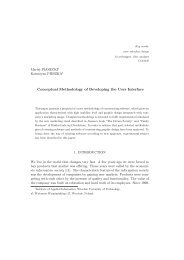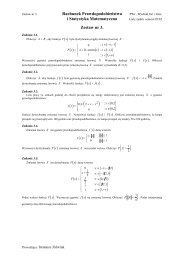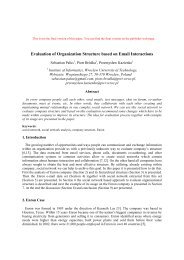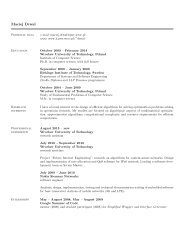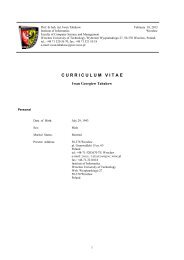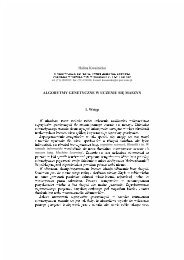Technical Report - Microsoft Research
Technical Report - Microsoft Research
Technical Report - Microsoft Research
Create successful ePaper yourself
Turn your PDF publications into a flip-book with our unique Google optimized e-Paper software.
point into the Exchange Heap. In particular, the kernel does not have pointers into a process’sobject space, nor does one process have a pointer to another process’ objects. This invariantensures that each process can be garbage collected and terminated without the cooperation ofother processes.The kernel creates a process by allocating memory sufficient to load an executable imagefrom a file stored in <strong>Microsoft</strong>’s portable executable (PE) format. Singularity then performsrelocations and fixups, including linking kernel ABI functions. The kernel starts the new processby creating a thread running at the image’s entry point, which is trusted thread startup code thatcalls the stack and page manager to initialize the process.A process obtains additional address space by calling the kernel’s page manager, whichreturns new, unshared pages. These pages need not be adjacent to the process’s existing addressspace, since the garbage collectors do not require the address space be contiguous, though theymay need contiguous regions for large objects or arrays. In addition to memory, which holds theprocess’s code and heap data, a process has a stack per thread and can access the Exchange Heap.3.3.1 Stack ManagementSingularity uses linked stacks to reduce the memory overhead of a thread. These stacks growon demand by adding non-contiguous segments of 4K or more. Singularity’s compiler performsstatic interprocedural analysis to optimize placement of overflow tests [51]. Each of thesecompiler-inserted checks is trusted code that accesses system data structures, residing in theprocess’s object space, to determine the amount of space remaining in the current stack segment.Before the running thread pushes a new stack frame which would potentially allow overflow ofthe current stack segment, the trusted code calls a kernel method, which disable interrupts andinvokes the page manager to allocate a new stack segment. This code also initializes the firststack frame in the segment—between the running procedure and its callee—to call the segmentunlink routine, which will deallocate the segment when the stack is popped. Since all processesrun in ring 0 on an x86, the current stack segment must always leave enough room for theprocessor to save an interrupt or exception frame, before the handler switches to a dedicatedinterrupt stack.3.3.2 Exchange HeapThe Exchange Heap, which underlies efficient communication in Singularity, holds datapassed between processes (Figure 2). The Exchange Heap is not garbage collected, but insteaduses reference counts to track usage of blocks of memory called regions. A process accesses aregion through a structure called an allocation.Allocations also reside in the Exchange Heap, which enables them to be passed betweenprocesses, but each is owned and accessible by a single process at a time. More than oneallocation may share read-only access to an underlying region. Moreover, the allocations canhave different base and bounds, which provide distinct views into the underlying data. Forexample, protocol processing code in a network stack can strip the encapsulated protocol headersoff a packet without copying it. A region tracks the number of allocations that point to it, and it isdeallocated when this reference count falls to zero. The Singularity compiler hides the extra levelof indirection through an allocation record by strongly typing references into a region andautomatically generating code to dereference through the record.3.3.3 ThreadsA process can create additional threads. Untrusted (but verified) code running in the processcreates a thread object, initializes it with a supplied function, and stores the object in an unusedslot in the run-time system’s thread table. This code then invokes ThreadHandle.Create,10





